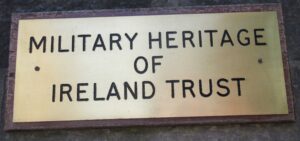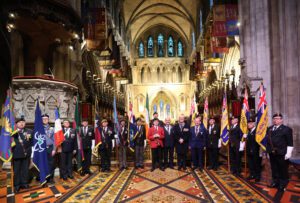Commodore Hugh Tully (NS) and Commodore Martin Quinn (RN) at the ceremony. On 31 May, a wreath laying ceremony took place on Alexendra Docks, Belfast, honouring 10,000 Irish personnel who served in the Royal Navy and Mercantile Navy during the First World War. In parallel, the refurbished HMS Caroline was opened as a visitor centre.
Descendants of the crew of HMS Caroline attended from Ireland, Australia, America, Britain, Canada and Spain. The Royal Navy and the Irish Naval Service participated in the ceremonies. Attendance included UK and Irish political and military representatives, along with representatives from the ports of Ireland, as Irish Lights and maritime emergency services.
 Receiving a grant of £11.5m from the Heritage Lottery Fund, the National Museum of the Royal Navy and the Department of Enterprise Trade and Investment jointly restored HMS Caroline.
Receiving a grant of £11.5m from the Heritage Lottery Fund, the National Museum of the Royal Navy and the Department of Enterprise Trade and Investment jointly restored HMS Caroline.
Now open to the public, visitors to HMS Caroline will avail of special effects and interactive exhibits, view its replica guns and visit the refurbished Wheelhouse, Captain’s Cabin, Royal Marine Mess, Engine Room, Sick bay and Galley Kitchen.
The official ceremonies marked the 100th anniversary of the Battle of Jutland.
On 31 May 1916, the British Royal Navy’s Fleet engaged the Imperial German Navy’s High Seas Fleet. Some 250 ships engaged in a 36 hour naval engagement in the North Sea off the coast of Denmark’s Jutland peninsula. British losses amounted to 6,784 men and 14 ships, with the Germans losing 3,058 men and 11 ships. The losses included 358 Irishmen serving in the Royal Navy.
HMS Caroline was one of the few ships remaining afloat after the Battle of Jutland. HMS Caroline was one of eight C-class light-cruisers ordered under the Admiralty’s 1913-1914 construction programme. Launched on 21 September 1914 in Birkenhead, HMS Caroline was commissioned on 4 December 1914. During her service, HMS Caroline protected trade by undertaking regular North Sea patrols and convoy screening in the First World War.
With the end of World War I, HMS Caroline saw service on the East Indies Station. In 1924, she moved to Belfast Docks and became the static, floating headquarters of the newly formed Ulster Division of the Royal Naval Volunteer Reserve. She is the last remaining British First World War light cruiser still afloat and the sole survivor of the Battle of Jutland.
On the outbreak of the Second World War, HMS Caroline became a depot ship to an anti-submarine striking force of patrol vessels. In 1940, this force was increased to 70 vessels. HMS Caroline provided signal and cypher facilities to her attached light craft. As the war developed, Belfast soon came to play a vital part in the Battle of the Atlantic.
In 1943, HMS Caroline became the strategic operations base for a force of Destroyers and Corvettes protecting convoys in the North Atlantic. Operations were planned and conducted directly from HMS Caroline where a total six escort groups, each composed of six frigates, were controlled.
After the Second World War, HMS Caroline became a floating training establishment for the Royal Navy Volunteer Reserve until 2009. At the time of her decommissioning in 2011, HMS Caroline was the second-oldest ship in Royal Navy service – the flagship HMS Victory can be visited in Portsmouth.




